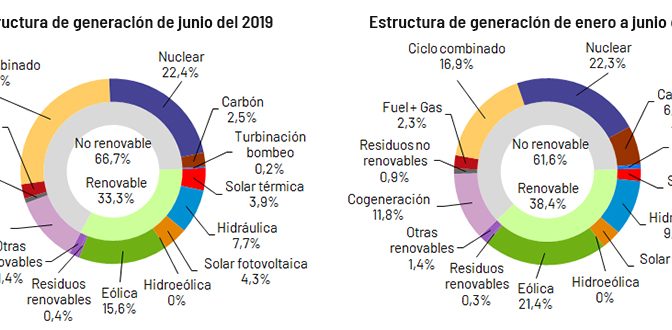Renewable energies generated 38.4% of electricity until June in Spain: wind energy 21.4%, solar thermal 2.2% and photovoltaic 3.5%. In June, wind power accounted for 15.6%, concentrated solar power for 3.9% and photovoltaic for 4.3%. Wind turbines generated 27,229 GWh of electricity in the first half of the year (21.4% of the national total) and was only surpassed by nuclear, which produced 22.3% of the total. 33.3% of total generation in June was of renewable origin and 55.9% was produced from technologies that do not emit CO2.

The demand for national electricity in June is estimated at 21,329 GWh, 1.3% lower than that recorded in the same month of the previous year. If the effects of the calendar and temperatures are taken into account, the figure drops by 2.6% compared to June 2018.
In the first six months of 2019, demand is estimated at 130,800 GWh, 2.1% less than in 2018. Again, once the influence of the calendar and temperatures has been corrected, the demand is 2.2% less than the one registered in the same period of the previous year.
During the first half of the year there is also a trend: the decoupling of the variation in energy demand from the national GDP is the result, among other reasons, of the increase in energy efficiency and changes in consumption habits. This new scenario, which we find in other European countries such as France and Germany, has been analyzed by Red Eléctrica in its study Electric demand and economic activity: Paradigm shift?
In the month of June and according to estimated data, generation from renewable energy sources represented 33.3% of production. 55.9% of electricity production this month came from technologies that do not emit CO2.
With information available to date, the production of wind farm origin in June reached 3,247 GWh, 23.4% higher than the same period last year, and accounted for 15.6% of national production. However, wind power, with 27,229 GWh of production, closed the month, being the second technology that contributed the most to the ‘mix’ from January to June, with 21.4% of the total.
In the peninsular electricity system, June demand is estimated at 20,043 GWh, 1.4% lower than that registered in the same month of the previous year. If the effects of the calendar and temperatures are taken into account, the figure drops by 2.9% compared to June 2018.
In the first six months of 2019, the demand for electricity in the Peninsula is estimated at 123,508 GWh, 2.2% less than in 2018. Again, once the influence of the calendar and temperatures has been corrected, the demand is 2.4% lower than that registered in the same period of the previous year.
During this month and according to estimated data, 34.6% of the peninsular generation was of renewable origin and 58.6% came from technologies that do not emit CO2. On the other hand, the wind registered 3,173 GWh, 23.3% higher than that of June last year, and contributed 16.1% to the ‘mix’.
The demand for electric power increases in the Balearic Islands and the Canary Islands
In the Balearic Islands, the demand for electric power in June is estimated at 542,429 MWh, 1.1% higher than that registered in the same month of the previous year. If the effects of the calendar and temperatures are taken into account, the figure increases by 1% compared to June 2018. In the first half of 2019, the Balearic demand is estimated at 2,786,967 MWh, 0.3% less than in 2018.
The combined cycle, with 41.4% of the total, was the first source of electricity generation in the Balearic Islands, where renewable technologies that do not emit CO2 represented 7.3%.
For its part, in the Canary archipelago the demand for electricity is estimated at 708,335 MWh, 0.1% higher than that registered in June 2018. If the effects of the calendar and temperatures are taken into account, the figure is maintained with Respect to the same month of previously year. From January to June, demand in the Canary Islands is estimated at 4,304,150 MWh and increases by 0.2% with respect to the same period of the previous year.
In the month of June and according to estimated data, the combined cycle was the leading technology in the Canarian generation mix, with a contribution of 31.6%. Renewables and technologies without emissions represented 13.1% of the Canarian generation.


